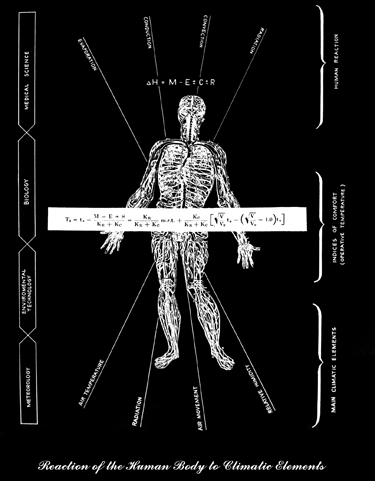A Machine for Climate:
The House Beautiful/AIA Climate Control Project
1949-1952
7.0 | Conclusion
Although the following statement is a harsher iteration of this idea, efficiency of both production and consumption are key interests expressed in the AIA reports and House Beautiful articles. This statement is reflective of some of the fears which encouraged an awareness and sensitivity toward the climate. In 1954, Harrison Brown wrote his book, The Challenge of Man's Future: An Inquiry Concerning the Condition of Man During the Years that Lie Ahead. A renowned American geochemist, he once worked on the Manhattan Project (supervising the production of plutonium) and taught at the California Institute of Technology. Later renouncing the production of weapons of mass destruction, he was also the author of a number of books dealing with the complicated topics of controlling population and allotment of natural resources. In this 1954 book, he writes;
'With increasing necessity and demand for efficiency, integration, and minimizing of waste in the economic world, there will be increasing demand for efficiency, integration, and minimizing of waste in the social world. These changes will have marked effects upon the ways in which men live. It seems clear that the first major penalty man will have to pay for his rapid consumption of the earth's non-renewable resources will be that of having to live in a world where his thoughts and actions are ever more strongly limited, where social organization has become all-pervasive, complex, and inflexible, and where the state completely dominates the actions of the individual.'23
The Legacy
The interest in climate-sensitive architecture was ultimately defeated at least in part by low oil and energy costs throughout the 1950s, the inability of the consumer and individual homeowner to undertake major construction alterations, and the dominance of privately-funded developments for profit and the availability of the tract home.
However, these publications became the foundation for further textbooks which became the bibles for 'designing with climate.' These include Aronin's Climate and Architecture and Olgyay's Design with Climate.
In 1953, a book by Jeffrey Ellis Aronin called Climate and Architecture was published by Progressive Architecture and Reinhold Publishing, specifically to detail to architects how climate could be used to better inform design. I would like to use this book as an example of comparative literature available at the time when the AIA climatology reports were being released to architects. The book looks at four categories of climate; sun, temperature, wind, and precipitation and its organization consists of some scientific diagrams (mostly sun charts) and equations for calculating the altitude of the sun, etc., combined with architectural photographs of buildings and drawings of more comprehensive sites. Regional climate specificities are discussed but not elaborated upon with design specifics provided for varying regions. Scientific means of studying climate are outlined and the projects of famous architects such as Frank Lloyd Wright are analyzed for their climate-appropriateness, however, there are no specific guidelines for designing for specific climates provided. In fact, in the few instances where detailed data charts are provided are excerpts from the House Beautiful Climate Control Guide which indicates that the House Beautiful project probably inspired subsequent texts such as these.
In 1963 Victor Olgyay published what would become a standard text in climate-sensitive design, Design with Climate. He builds off of the House Beautiful project, using the AIA's charts as an example. Not only his research, but also his diagrams make large strides in visually expressing the impact of climate on the human body in the built environment. Olgyay's goal, outlined in his 1963 book is also that of the House Beautiful Climate Control Project. Olgyay writes that; '[t]he shelter...modifies the natural environment to approach optimum conditions of livability. It should filter, absorb, or repel environmental elements according to their beneficial or adverse contributions to man's comfort. Ideally, the satisfaction of all physiological needs would constitute the criterion of an environmentally balanced shelter.'24 At times, however, he may abstract the data a bit too much, as the diagram below suggests.

Diagram from Victor Olgyay's 1963 text Design with Climate.